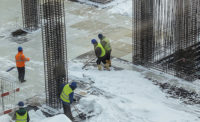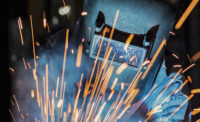Companies often invest a considerable amount of time in modular, yet stable, warehouse furniture, fittings and shelving, and for a good reason. A proper layout can significantly impact productivity, safety and operations. Unfortunately, it often means warehouse floor maintenance falls by the wayside.
Warehouse maintenance, in general, is about more than just what's inside the facility, but also the structure itself, including the flooring. Each year, Americans lose around 95 million workdays due to slip-and-fall-type accidents. The same accidents are also among the leading causes of workers' compensation claims, costing about $20,000 per incident.
Some of those are likely from spills and similar hazards, but most are going to come from the style of flooring used in a warehouse and its conditions. Unkempt and unmaintained flooring will do a number on safety and productivity levels. It's not enough to have a stable, well-finished and safe floor — it also requires regular maintenance to stay that way, including thorough cleanings.
Choosing flooring materials and addressing maintenance
Choosing the right flooring material for a warehouse is an important step, but still only a fraction of the larger equation. Most warehouses feature utilitarian options, like polished concrete and epoxy. Tile, wood and other types of finished flooring can scuff, crack and warp over time. Warehouses aren't the cleanest environments, so there's little question that the floor must be heavy duty.
The answer is to choose wisely between the most popular types of durable flooring, with today's and tomorrow's business needs in mind. Here's what to know about the two most common flooring types in warehouses and how to address their maintenance requirements.
Polished concrete floors
Polished concrete is a good choice for work environments hosting light- to medium-duty activities. It provides a non-porous structure that resists light damage and peeling.
One variant of polished concrete, superflat concrete floors, provides extremely level surfaces with tighter tolerances. This characteristic is obtained by pouring the concrete in narrow strips.
Polished concrete requires simple maintenance practices over time, including re-polishing. Even so, the generally lower installation and ongoing costs continue to prove attractive to warehouse owners.
Epoxy floors
Epoxy flooring options are typically costlier than concrete alternatives, but the result is a floor that stands up better against the harshest industrial abuse. Unlike concrete variants, epoxy flooring provides resistance to chemicals and even acids.
It is not necessary to re-polish these floors over time. In fact, this material's maintenance requirements are negligible. Therefore, epoxy's ongoing maintenance costs typically prove lower over time than polished concrete.
However, these floors come with higher costs for installation and don't last as long as polished concrete. It may also take more than one coat of epoxy to achieve the same non-porosity as polished concrete.
Addressing maintenance
To summarize, epoxy flooring lacks longevity but is more cost-effective to maintain. Both flooring types still do require some types of regular care and cleaning, however.
Implementing proper maintenance policies will further address floor safety concerns and stop contaminants like chemicals, moisture, dust, dirt and debris from compromising the work environment, the products or the floor itself. Here are some pointers:
- Each facility should have a detailed workflow for caring for the flooring itself, outlining each task and who's responsible and when.
- Facility managers should deal with scuffs, gouges and other light damage before the condition worsens into a costlier repair.
- A professional maintenance company should reapply protective coatings or finishes according to manufacturer recommendations and the amount of traffic seen in the facility.
- Employees should receive training to spot and report standing water, spills or signs of damage right away, so neither safety nor the flooring itself are compromised.
Each of these maintenance points contributes to a higher level of safety and productivity for the workers who spend most of their time inside the facility.
Keeping the warehouse floor clean
Keeping your warehouse floors clean can feel like a full-time job, yet it's essential for compliance and employee safety. Here are some quick, yet vital, tips for keeping a warehouse floor clean and safe:
- Always pick up dirt, dust and debris: Larger debris can cause workers to slip and fall, but the same is true of even smaller contaminants like dust. With treated concrete and superflat floors, things can get slippery quickly.
- Sweep the floors daily, even when they don't look dirty: Not only will this remove potential failure points, but it also makes the rest of the cleaning process much more effective. Have you ever tried to mop a floor before sweeping or vacuuming it?
- Prioritize active processes, not a single task: Empower everyone within the warehouse by encouraging active cleaning and maintenance protocols. If workers are more responsible for cleaning up messes they create or encounter, there's less cleaning to do at the end of each day.
- Choose the right floor cleaning solution: Chemicals are excellent at cleaning, but there are various kinds meant to work with unique types of flooring and applications. Also, consider the ingredients of the cleaner, not only concerning the floor, but also worker health and safety. If a solution makes a floor too slick, or it has toxic ingredients that might cause respiratory issues, avoid it.
- Issue the right safety gear: Many floor cleaning solutions come in high concentrations and are not ideal for the skin and body. Be sure that maintenance crews have the appropriate PPE, as well as anyone that will come into contact with cleaning supplies and solutions.
- Modify and improve equipment: It's possible to install tires on machinery and equipment that are less damaging to the floors. That's a good idea, but it's not always necessary. It's more crucial to ensure equipment is in proper working order. By keeping machinery and gear in a better state, the rest of the warehouse benefits, including the floor. A forklift with a damaged lift system, for instance, might be causing divots and cracks in the substrate.
- Mind the gaps: A variety of events and tasks will create messes and wear down a floor over time. For example, trucks coming into a dock from outside might spread mud, dirt and even salt during the winter months. All these things can damage the floor and spread throughout the warehouse. Workers spending time in messy spots can track the grime all over. Warehouse managers should check these areas and clean them throughout the day.
- Hire professionals: It may be a better option to hire professional cleaning services to handle the responsibility, so warehouse workers can focus on what they do best. Doing so will have a significant impact on productivity, as no one from the front line has to stop what they're doing to clean an area. Instead, third-party cleaners can handle it.
The floor matters
It wouldn't make sense to build a structure or facility on top of an unstable, decrepit foundation. The base is what provides the strength, longevity and integrity. The same is true of a warehouse floor, which supports nearly anything that happens inside a facility.
The floor materials, conditions and maintenance matter. It's time to give it the appropriate priority if that hasn't already happened within your facilities. By implementing efficient cleaning and care practices, both productivity and safety






